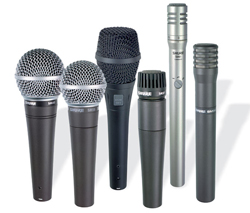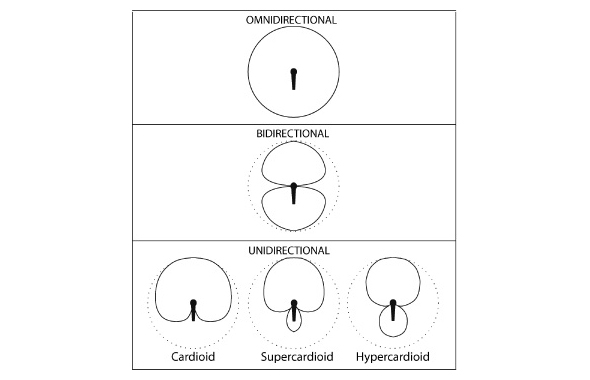Here’s a highly simplified explanation of mic specs in plain English. It may help you evaluate microphones based on their specifications.
MICROPHONE TYPE: Dynamic, condenser, ribbon
These terms refer to the way the microphone converts sound into an electrical signal. Each type has its own “sound” and application.
Dynamic: Good sound quality, rugged. Popular for guitar amps and drums. Does not require phantom power.
Condenser: High-fidelity, detailed sound with lots of clean high frequencies. Popular for studio vocals, stage vocals, acoustic instruments and cymbals. Requires “phantom power” from a mixer to operate. Can be miniaturized.
Ribbon: Warm, smooth sound quality. Delicate. Popular for horns and guitar amps. Does not require phantom power.
FREQUENCY RESPONSE: The lowest and highest frequencies that the mic can pick up well.
A frequency response from 20 Hz to 20,000 Hz covers all of the frequencies we can hear. 80 Hz to 15,000 Hz is adequate for most instruments and vocals. 40 Hz to 10 kHz is adequate for bass instruments.
If the mic’s data sheet shows a frequency response graph, the shape of the dark line or “curve” on the graph indicates how the mic responds to bass, midrange and treble frequencies.
The right area of the graph is treble; the left area is bass, and the middle area is the midrange.
A curve that is mostly a horizontal line is called “flat.” It tends to sound accurate, natural or similar to what your ears hear.
A curve that rises above “0 dB” toward the right side of the graph has a “presence peak”. It tends to sound bright, trebly or articulate.
A curve that falls below “0 dB” toward the right side of the graph tends to sound mellow.
A curve that falls below “0 dB” toward the left side of the graph is called a low-frequency rol-loff. It’s desirable to roll off the low frequencies below the lowest note that the instrument or vocal produces.
Proximity Effect: Most microphones boost the bass when used up close. That adds a warm, full tone quality. Microphones with an omnidirectional polar pattern do not have proximity effect.
POLAR PATTERN: A graph showing how a mic picks up sounds from different directions. (Also called directional pickup pattern.)
Cardioid: Picks up best in front of the mic. Partly rejects sounds approaching the sides or rear of the mic. Rejects sound best toward the rear.
Supercardioid: Picks up best in front of the mic. Partly rejects sounds approaching the sides or rear of the mic. “Tighter” or more narrow pickup than cardioid.
Hypercardioid: Picks up best in front of the mic. Partly rejects sounds approaching the sides or rear of the mic. “Tighter” or more narrow pickup than supercardioid.
Omnidirectional (or “omni”): Picks up equally well in all directions. Unlike the other patterns, omni has no proximity effect (no up-close bass boost).
Bidirectional or Figure-8: Picks up best in two directions—in front of and behind the mic—and rejects sounds to the sides.
Use cardioid, supercardioid, hypercardioid, bidirectional, or an instrument-mounted omni when you want to reject background noise, room acoustics and feedback. A mic with one of those patterns tends to pick up mostly what it is aiming at, and not so much of everything else.
Use omnidirectional when you want to pick up everything around the microphone.



























